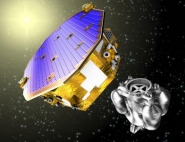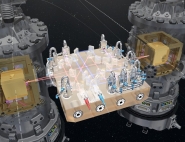CNES projects library
C
I
M
P
S
U
Lisa Pathfinder
The European Space Agency (ESA) is pursuing an ambitious physics mission about the gravitational Universe (L3 mission) that aims to directly observe gravitational waves—the tiny ripples in the fabric of space-time predicted by Einstein’s theory of general relativity—using 3 satellites forming a giant optical interferometer. The presence of these waves will be signalled by minute relative movements between 2 test masses in free fall at the end of each of the interferometer’s arms.
LISA Pathfinder is a scaled-down model of an interferometer arm packed into a single satellite that tests key technologies required to place the 2 test masses in perfect free-fall conditions and measure their relative movement with unprecedented precision. LISA Pathfinder also draws on the very latest developments to minimize other forces acting on the masses housed inside the LTP instrument (LISA Technology Package) and to measure their movement. With its inertial sensors, laser metrology, drag-free control and ultra-precise micro-propulsion systems, it is a truly ground-breaking mission.
CNES and its partners in the French consortium coordinated by the APC astro-particles and cosmology laboratory are involved in this ESA-led mission for which they are supplying a subsystem of the LTP instrument’s optical bench. They will also be performing operational science data analysis once the satellite is in orbit.
Mission's news feed
-

LISA Pathfinder - End of a successful mission
Tuesday 18 July, the LISA Pathfinder satellite received its last command to shut down after the final series of science commands uplinked by ESA at the end of June.
October 17, 2017
-

Test cubes floating freely inside LISA Pathfinder
ESA’s LISA Pathfinder has released both of its gold–platinum cubes, and will shortly begin its demanding science mission
February 16, 2016
-
Press Release: Vega launches successfully on sixth flight from Guiana Space Center
Thursday 3 December, Vega accomplished a flawless launch from Europe’s spaceport at the Guiana Space Centre (CSG) on its sixth successful mission since its maiden flight in 2012,...
December 3, 2015

